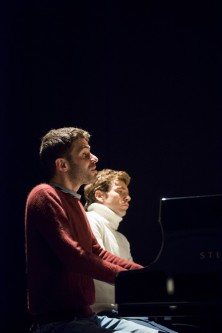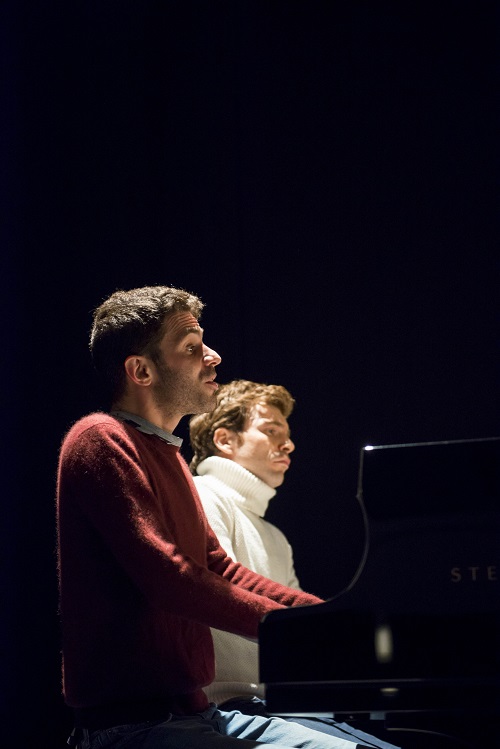 United Kingdom Schubert, Ravel, Stravinsky: Adam Laloum (piano), David Kadouch (piano), Institut Français, London, 19.3.2016 (RB)
United Kingdom Schubert, Ravel, Stravinsky: Adam Laloum (piano), David Kadouch (piano), Institut Français, London, 19.3.2016 (RB)

Schubert – Lebenstürme D947
Ravel – Ma mère l’Oye
Schubert – Fantasie D940
Stravinsky – Le sacre du printemps
This event formed part of the It’s All About Piano series at the Institut Français which this year was dedicated to youth. The concert by French pianists Adam Laloum and David Kadouch was held at the comfortable Ciné Lumière which forms part of the Institut. The programme notes were helpful in providing information and interviews with the various artists who were performing but there was no information about the music itself – something perhaps for the organisers to look at for next year.
Schubert wrote Lebenstürme in the final year of his short life, immediately after the haunting F minor Fantasie for piano duet. It was probably intended as the first movement of a sonata which the composer did not have time to complete, although the Rondo in A major D951 could possibly have been the finale. The fanciful title Lebenstürme (‘Storms of Life’) was added by the publisher Diabelli on the work’s posthumous publication. Laloum took the primo role in this performance and he and Kadouch opened the recital in dramatic style with some powerful orchestral chords. This was a very Classical performance of the work with elegant phrasing, brilliantly executed passage-work and a keen eye to motivic and tempo relationships. I wondered if there might be scope to allow the music to breathe and sing more in the lyrical episodes and to give a greater emphasis to the extraordinary modulations. However, this was a very strong and accomplished opening to the recital.
Ravel’s Ma mère l’Oye (‘Mother Goose’) was originally written for piano duet for the Godebski children. This was a terrific performance of this work by Laloum and Kadouch with both performers doing a superb job capturing the sense of childlike wonder that permeates the work. We were immediately catapulted into the world of fairy tales in Pavanne de la Belle au bois dormant which had an ethereal delicacy and captured the fragile, evocative atmosphere of the scene to perfection. The pedal was used to superb effect in Petit Poucet with the opening progressions sustained in a magical and beautifully nuanced way before Laloum gave us scintillating, brilliant pentatonic effects in Laideronette, imperatrice des pagodes. Les entretiens de la Belle et de la Bête opened as a demure elegant dance before Kadouch produced the grunts and growls of the beast (portrayed by the contrabassoon in the orchestral version). Le Jardin Féerique had a glistening delicacy before cascades of glissandi from Laloum brought the work to its enchanting close.
The next work on the programme was Schubert’s wonderful F minor Fantasie which was also written in the last year of composer’s short life and dedicated to his pupil, Karoline Esterházy. It is one of the greatest and most original works for piano duet ever written. Kadouch switched to the primo role for both this and the final work on the programme. Kadouch and Laloum did an excellent job with the haunting melody which opens the work and the handling of the modulations was exceptionally sensitive. The Largo section with its dotted chords and trills was played with enormous power with both players making the most of the composer’s dynamic contrasts while maintaining beauty of tone. I was less convinced by the scherzo which occasionally sounded a little mannered and self-conscious and lacked the carefree sparkle that can illuminate the work. In the final fugue I felt the performers were perhaps pushing the tempo a little too much and I would have welcomed a better graduated build up in this movement.
The concert concluded with Stravinsky’s masterpiece Le sacre du printemps which received its notorious first performance in Paris in 1913. After this scandalous opening night, the work originally became better known through a transcription for piano duet and Stravinsky famously performed this version himself with Debussy on the second piano. The famous opening melody which opens the work was sensuous and evocative and the performers did well in not becoming distracted by some movement in the audience. The work requires enormous virtuosity and both performers had their technical wizardry on full display as we moved into the explosive cycle of dances. Both performers allowed the violence and primitivism of the score to spill out and they played with precision and flair. The slower central sections of the work had an intoxicating quality as one became increasingly mesmerised by the tribal rituals. There was imaginative use of tone colour enhanced by skilful rhythmic motifs. I was impressed with the knife edge precision by both performers in the final sequence of dances before a barnstorming display of virtuosity brought the work to its thrilling conclusion.
Overall, we heard a good deal of superb playing by Laloum and Kadouch, particularly in the 20th Century repertoire.
Robert Beattie
